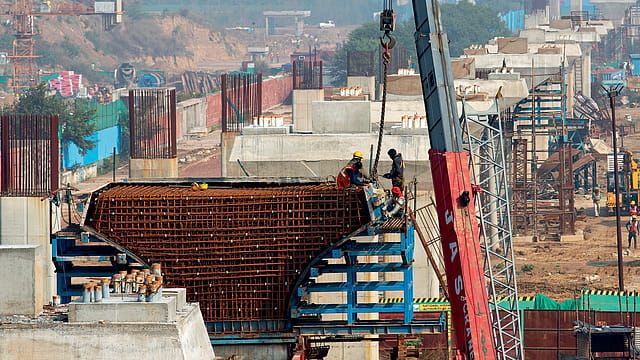Centre Spending Boosts Infra Companies

Construction of infrastructure, especially highways, has been Central government's most important economic agenda to lift GDP growth. The massive capital spending has resulted in a sharp improvement in profitability of infrastructure development firms.
Since FY20, Centre has undertaken capital expenditure of ₹21.26 lakh crore in order to boost private investment and consumption through the multiplier effect. This is 14.42% of India's ₹147.36 lakh crore real GDP and 9% of its ₹236.65 lakh crore nominal GDP for FY22. The impact is visible in first quarter FY23 numbers of infrastructure construction companies. Most have improved their net profit margin significantly over the pre-pandemic quarter of December 2019. This is clearly showing in their bottom lines.
Highway construction major IRB Infrastructure Developers reported a five-fold jump in consolidated net profit in Q1 of FY23 to ₹363.20 crore compared with ₹72 crore in corresponding quarter of the previous financial year. Net profit margin more than doubled to 18.87% compared with 9.17% in Q3 of FY20. The company had slipped into a loss in June and September 2020 quarters in the wake of the national lockdown.
Other companies that have reported a significant boost to profitability during the period (Q1 FY23 vs Q3 FY20) are Ashoka Buildcon (7.16% vs 2.53%), PNC Infratech (11.72% Vs. 4.81%), KNR Construction (9.14% Vs. 8.59%) and Ramky Infrastructure (1.27% Vs. -18.91%), as per a Fortune India analysis of companies in the space. While L&T's profit margin in the infrastructure segment fell to 4.75% compared with 6.49% in Q3 FY20, the company is upbeat about the tendering environment and the capital expenditure opportunity offered by Central and state governments. "The domestic ordering environment in Q1 was significantly better compared to Q1 of previous year. At macro level, there was improvement in domestic tendering and awarding activity. Secondly, we expect public capex spends of centre, states and public sector units to be better than in previous year," says P. Ramakrishnan, vice president, L&T Ltd. "The government's persistent efforts to jumpstart economic growth through higher infrastructure spending and incentivising domestic manufacturing should yield benefits in the medium term. Private capex should possibly join this bandwagon in a couple of quarters," he says.
Even companies that have reported a tepid performance are upbeat about the future. Infrastructure construction major Nagarjuna Construction Company Ltd. reported consolidated net profit margin of 3.9% in Q1 FY23 compared with 4.55% in Q3 FY20 quarter but is confident that profitability will improve from here on. P.V. Vijay Kumar, vice president (finance), NCC Ltd., said during an earnings call that "profit after tax margins are likely to improve. We are at now at 4.01% (standalone). This may hover around 4.5%." Kumar acknowledged that government's support to infrastructure has created traction in the sector. "Government is rightly supporting infrastructure and construction segments. In the recent Budget, you can see the government giving a lot of thrust to infrastructure spending. It has a good chance of driving consumption and growth in the economy."
GR Infrastructure, which brought its initial public offering in 2021, reported a consolidated net profit margin of 15.04% in June quarter, up from 9.40% in September quarter of FY22. It is bullish on the government's target of awarding 330 highway projects worth ₹2.3 lakh crore in current financial year.
Order Book Swells
Ahead of announcement of Q1 results, an HDFC Securities report listed some positives for the infrastructure sector. "Q1 starts on a good note for infrastructure. Competitive intensity cools off, and commodity prices correct," it said in a research report, adding that "the capital goods sector will benefit from revival of private capex and realignment of global supply chains. Capital goods companies are witnessing strong order bookings and may continue to report all-time-high order books. Despite high inflation, pricing power is cushioning margin erosion."
L&T's infrastructure project segment, for example, reported order inflows of ₹18,343 crore in first quarter of current financial year, up 66% from corresponding quarter of previous year. International orders, at ₹4,691 crore, accounted for 26% of the total. "The segment order book stood at ₹2,63,977 crore as on June 30, 2022, with share of international orders at 23%," said the company. IRB's order book stood at ₹15,700 crore in quarter ended June 30 compared with ₹13,280 crore in Q1 of FY22. The total order book of NCC Ltd. stood at ₹40,616 crore compared with ₹38,000 crore in same quarter last year. GR Infraprojects boasts an order book of ₹17,005 crore, up from ₹15,058 crore in quarter ended June 2021. Adani Road Transport Ltd, a group company of Adani Enterprises, had an order book of ₹34,000 crore in Q1 of FY23 and a portfolio of 14 road projects. The company constructed 123 lane kilometres compared with 24 lane kilometres in corresponding quarter of previous fiscal year. It plans to construct 12,000 lane kilometres by 2026.
Central government's spending plans for FY23 also bode well for these companies. For the current financial year, the Centre has lined up capital expenditure ₹7,50,000 crore. With eye on quick execution, allocations have been front-loaded, shows data from finance ministry. Almost one-fourth of the total allocation, ₹1,75,064, has been utilised in the April-June period. A total of ₹78,000 crore was spent in April itself.
Infrastructure companies may ride profitability wave in the coming years on the back of colossal budgetary allocations, speedy disbursements, declining global commodity prices and public capital expenditure crowding in private investments.